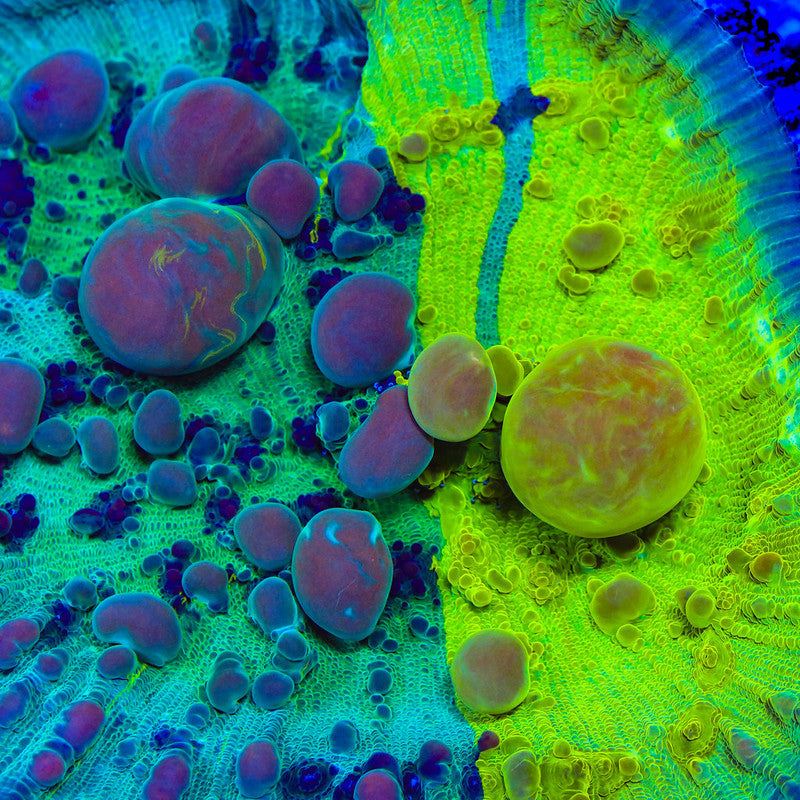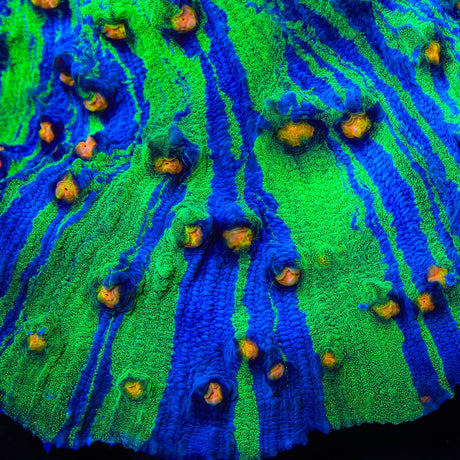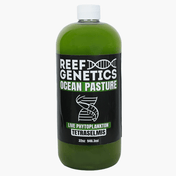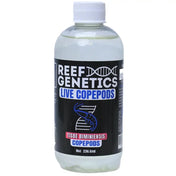Introduction: What is Chalice Coral
Chalice corals are a highly sought-after large polyp stony (LPS) coral that helps reef aquarium enthusiasts achieve stunning coloration and dynamic growth in their tanks. In this guide, you’ll learn what chalice corals are, why it’s prized by hobbyists, and how to care for it successfully.
This comprehensive guide covers coral identification, care requirements, propagation techniques, and troubleshooting common issues. Whether you’re a beginner setting up your first reef tank or an experienced reef keeper looking to expand your coral collection, this article guides you through how to successfully care for chalice coral.
Understanding Chalice Corals
Chalice corals are large polyp stony corals characterized by their distinctive cup-shaped or plating growth forms. These beautiful coral species belong to several main genera: Echinophyllia sp, Oxypora sp, Mycedium, and Echinopora.
Understanding coral anatomy is key before diving into care requirements. Chalice corals feature polyps with distinct mouths surrounded by flesh, creating the characteristic “eyes” that give many species their common names like Mummy Eye or Hollywood Stunner. Chalice corals also produce a protective mucus layer, which plays a role in feeding and defense. The skeleton grows in flat, plate-like formations that can extend horizontally across rocks in your reef aquarium. When placing a chalice coral specimen, be sure to allow space from neighboring corals to prevent aggression from their sweeper tentacles.
Chalice corals are especially prized for their bold green and purple hues, among other striking colors, making them highly desirable for reef tanks.
Optimal Water Parameters:
- pH: 8.1-8.4
- Salinity: 1.026
- Calcium: 450 ppm
- Alkalinity: 8-9 dKH
- Magnesium: 1250-1350 ppm
- Temperature: 76-78°F
Types of Chalice Corals and Their Growth Rates
Chalice corals are a diverse group within the large polyp stony (LPS) coral family, captivating reef hobbyists with their vibrant coloration and unique growth forms. These corals span several genera, including Echinophyllia, Oxypora, and Mycedium, each offering distinct appearances and patterns. The dazzling colors and intricate designs of chalice corals make them a centerpiece in any reef aquarium, with many species displaying eye-catching contrasts and swirling patterns that set them apart from other corals.
Growth rates among chalice corals can vary significantly depending on the species and the thickness of their skeletons. For example, thin-skeleton varieties like the Miami Hurricane are known for their rapid growth, often doubling in size within just four months under optimal conditions. In contrast, thick-skeleton species tend to grow more slowly, typically adding about a quarter inch per month. This variation allows hobbyists to choose chalices that best fit their reef’s needs and their own patience level.
No matter the species, chalice corals reward proper care with beautiful coral displays and steady growth. Their popularity in the reef hobby is driven by their stunning coloration, unique forms, and the satisfaction of watching these corals thrive and expand in a well-maintained aquarium.
Step-by-Step Guide to Successful Chalice Coral Care
Step 1: Tank Parameter and Water Parameter Preparation
Essential equipment includes proper lighting systems capable of providing 75-200 PAR at coral placement depth, powerheads for moderate water movement, and comprehensive water testing kits for monitoring parameters. Your reef tank should maintain stable conditions with calcium and magnesium at proper levels to support skeletal growth.
Target water parameters must remain consistent: pH between 8.1-8.4, salinity at 1.026, calcium around 450 ppm, alkalinity at 8-9 dKH, and magnesium between 1250-1350 ppm. Tank water stability proves more important than chasing perfect numbers.
Step 2: Placement and Acclimation
Optimal placement positions chalices in bottom to middle tank areas where they receive moderate lighting without too much flow. These corals require at least an inch of spacing from other corals due to their aggressive sweeper tentacles that extend at night. Position specimens on rocks or sand where their flat growth form can expand naturally.
Gradual light acclimation prevents bleaching and tissue loss. Start new specimens under lower levels of lighting and gradually increase intensity over 2-3 weeks. Use a frag plug or coral glue to secure small frags to rocks, ensuring proper positioning for future growth.
Step 3: Ongoing Care and Monitoring
Feed chalices twice weekly using turkey baster to target-feed mysis shrimp, powdered phytoplankton, coral food, or phytoplankton directly to their mouths. Proper feeding enhances coloration and growth rate while supporting the coral’s energy needs beyond photosynthesis.
Monitor water movement to prevent detritus buildup in cup-shaped colonies while avoiding too much flow that prevents polyps from extending. Remove accumulated debris gently with the turkey baster during regular maintenance.
Success metrics include consistent polyp extension, vibrant coloration maintenance, and measurable growth over months. Healthy specimens will show active feeding responses and steady tissue expansion.
Fragging and Propagation of Chalice Corals
Fragging chalice corals is a popular method among reef hobbyists for propagating these beautiful coral specimens and sharing them with others. The process begins by carefully selecting a healthy chalice coral and using bone cutters or a scalpel to create a small frag, ensuring that each piece contains at least one mouth or “eye.” This is crucial, as the mouth allows the new frag to feed and recover more effectively.
When fragging, it’s important to avoid cutting directly through the eyes and to preserve a mix of the coral’s vibrant coloration for the most attractive results. After cutting, each frag should be gently dipped in an iodine solution to help prevent bacterial infections during the healing process. The frag can then be attached to a frag plug using coral glue, providing a stable base for growth in the reef aquarium.
Proper care after fragging is essential for success. Place the new frags in an area with moderate flow and suitable lighting conditions, allowing them to acclimate and begin growing. Feeding the frags with appropriate foods using a turkey baster can encourage faster recovery and growth. Always handle chalice corals gently during propagation, and clean your tools between cuts to minimize stress and reduce the risk of spreading aggression or disease.
With attention to detail and the right conditions, chalice coral frags can quickly establish themselves, displaying the same vibrant coloration and unique patterns as the parent colony. This makes chalice corals an excellent choice for propagation, allowing hobbyists to expand their collections and contribute to the sustainability of the reef aquarium hobby.
Common Mistakes to Avoid
Mistake 1: Too high lighting causing rapid bleaching and tissue loss. Many hobbyists assume more light equals better growth, but chalices prefer moderate lighting levels and will bleach under intense illumination.
Mistake 2: Placing chalices too close together, leading to chemical warfare between colonies. Even different chalice species will attack each other with long sweepers, requiring careful spacing in your reef aquarium.
Mistake 3: Inadequate water flow allowing detritus buildup in cup-shaped colonies. Poor water movement leads to tissue recession and bacterial infections as organic matter accumulates.
Mistake 4: Overfeeding causing water quality issues and coral stress. While feeding enhances growth, excessive food degrades tank water and can cause tissue swelling.
Pro Tip: Start with moderate parameters and adjust gradually based on coral response. Chalices communicate their health through polyp extension and coloration - learn to read these signals for successful long-term care.
FAQs about Chalice Coral
Q1: How fast do chalice corals grow and when will I see results?
A1: Growth varies by species - thin skeleton varieties can double in 4 months, while thicker species grow about ¼ inch monthly under optimal conditions.
Q2: Can I keep different chalice species together in the same tank?
A2: Yes, but maintain adequate spacing (6+ inches) as they’re aggressive and will attack neighbors with sweeper tentacles.
Q3: What’s the difference between Echinophyllia and Oxypora chalices?
A3: Echinophyllia have bright, contrasting eyes and smooth texture, while Oxypora feature jagged ridges and eyes that blend into the body.
Q4: How do I propagate chalice corals successfully?
A4: Use bone cutters to break pieces including at least one eye, glue to frag plugs, and perform iodine dips to prevent infection during healing.
Conclusion: Key Takeaways
The five most important points for chalice coral care include: moderate lighting (75-200 PAR), stable water parameters, proper spacing from other corals, regular feeding with appropriate foods, and gradual acclimation to prevent shock.
Chalice corals reward consistent care and attention to detail with spectacular growth and coloration. These specimens represent one coral hobby segment where proper care requirements lead to impressive results in any reef tank.
Start your chalice journey with hardy species like Miami Hurricane or Avatar chalices, available through local fish stores and reputable online vendors. Focus on understanding the specific needs of your chosen species, and you’ll enjoy years of success with these magnificent corals in your home aquarium.


























